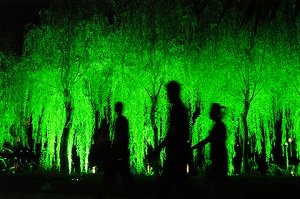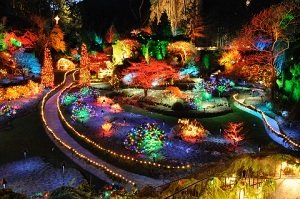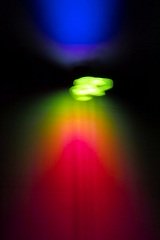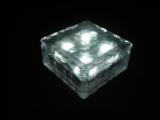Coloured-Garden-Lights
Coloured-Garden-Lights create psychological effects in the garden like paint colours do in interiors.
Ultimately, everyone has an opinion
whether we like it or not
but yours matters most
The important thing to know is that adding colour will alter the appearance of objects in unexpected (good or bad) ways.
 Coloured Lighting
Coloured Lighting
If we talk about colour, we are talking about both Hue (the actual colour Example; red, green, blue) and Colour Temperature (the amount of red or blue present in a beam of light).
Yup, colour temperature once again you may have skipped that part and Im over-simplifying here. See the Colour Temperature section if you want to know more.
Cool sources high in blue and green light can feel slightly eerie though they also give the garden an exciting sense of mystery and spaciousness.
 Coloured Lighting
Coloured Lighting
Using warm lighting (low colour temperature of say, 3500-4000 Kelvin ) will render people, objects food and plants more realistically and create a more comfortable atmosphere in the garden (like sunlight) than a higher colour temperature will.
Blue , blue-white lighting enhances the colour of green foliage, but will give other colours washed-out or bleached-out appearance.
Yellow and Amber light make green plants look bleached out and sick.
Red looks unnatural and hot.
There are several ways to introduce Coloured-Garden-Lights without purchasing a single colour filter
Cheapest Way
Use lights of different colour temperatures (in the 3500 - 4000 K range). Use dimmers. When you dim any light, notice that its colour becomes warmer! the colour shifts toward the red (lower) end of the Kelvin scale.If you also intend to use incandescent lamps, choose lower wattage bulbs around 40 Watts.
If you do mix light sources lets say you use one type of lamp as your main light source and use others for specific reasons like marking an important focal point , a specific plant or an entryway.
For small gardens this mixed technique may be more than you need and may even be confusing.
Coloured gels similar to those used in stage and television lighting could be another solution for you while yet another way to get colour in your night garden is to install tinted flood lights or coloured lenses in the lighting fixture.
This is the most commonly used lighting technique in coloured lighting, but it should be used carefully if effects are not to be too strong. Use colour to emphasize what is important in the garden.
You will heighten the impact of colour if you use it in a sparing way. Using mainly white light and allowing colour for enhancement or drama. Show visitors what you want them to look at.
This has been the minimalist approach. HOWEVER if youre a MAXIMAMALIST I toast you! Not many people have the courage to be you and awesome creativity is you strength!
Experiment with your Coloured-Garden-Lights and explore! Send pictures. hee-hee!


